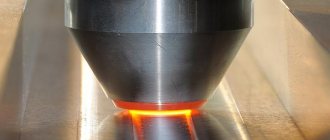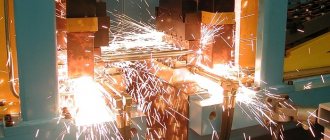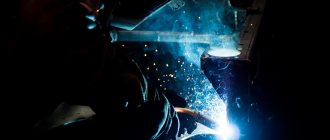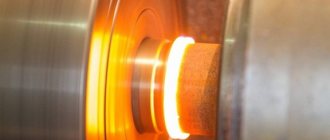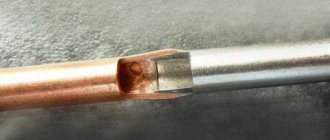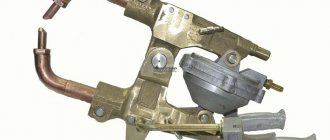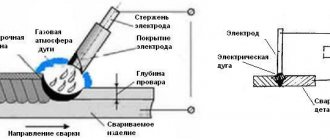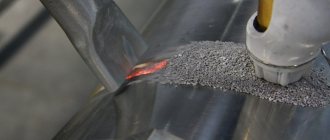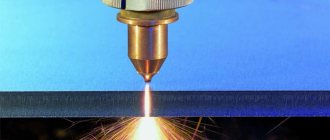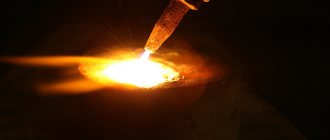Resistance (or electric contact) welding is one of the most common types of welding, most often used for fastening thin metal sheets or small parts of the same type. With this method, a short-term heating of the surfaces being connected occurs with a high voltage current, and simultaneous pressing of them against each other in the contact zone, resulting in the formation of a weld. Due to its simplicity, high productivity and low costs for consumables, this method is often used in production.
Resistance welding technology
Modern resistance welding involves the use of electric current, due to which the metal is connected to each other. The resistance welding method under consideration involves the formation of an electric arc that melts the metal. As the temperature in the affected area increases, the metal becomes plastic, due to which the molecules begin to connect with each other. The features of the contact welding method include the following points:
- The power of the resulting arc is influenced by the magnitude of the current. That is why the technology is used to connect a wide variety of parts. As the current increases, it becomes possible to work with thick metals.
- The exposure time and compression force of the metals also influence the result obtained. It is worth considering that the advantages of contact welding lie precisely in the fixation of the elements being connected. Due to this, the quality of the resulting seam is significantly improved.
In general, we can say that through the use of special equipment, welding points are created.
Today, there are various types of resistance welding. The most widespread are the following:
- Suture.
- Spot.
- Embossed.
- Butt.
Resistance seam welding
Resistance welding can be controlled using special equipment, which you can make yourself or purchase at a specialized store. It is worth considering that a conventional welding machine is not suitable in such a case.
Operating principle of the equipment
Various devices can be used to carry out resistance welding. Depending on the conditions, the equipment can be suspended, stationary or portable. Often devices have a narrow specialization, but there are universal devices on sale.
Resistance welding of stainless steel and other types of metal requires the welder to have certain training and special skills, which is why it is often used in production. Electric welding is especially popular, but manual methods are used much less frequently; these devices are usually found in auto repair shops and construction sites.
It is worth noting! Every welder must know what kind of electric current is used in resistance welding. As stated above, it should not be less than 1000 Amperes, preferably more. This indicator ensures high speed and productivity of the welding process.
The resistance welding device consists of the following important components:
- Mechanical elements. In addition to electrodes, they include components for compressing the welded parts and rollers. On stationary devices, hydraulics are used to create the required pressure and roll metal blanks.
- The electrical part is based on a welding type transformer. It also includes circuit breakers and other necessary components that supply current to the welded area, creating the required voltage in AC or DC mode.
- Complex equipment contains a lot of electronics, which allows the use of different modes of contact technology. It can also be used to regulate resistance welding current and other important operations.
Essence of the process
The resistance welding process is based on short-term exposure to current of varying strength. As it passes through the metal, it heats up, thereby significantly increasing the degree of ductility. The main positive features include the following:
- When using the technology under consideration, heat is generated in the body of the workpiece itself. In order to eliminate the possibility of heat spreading throughout the material, its feed rate must be high. That is why special welding equipment is used.
- The supplied current should be high and the heating time should be short. As practice shows, the power during the processing in question amounts to several hundred and even thousands of Amperes. In this case, the exposure time is only a few fractions of seconds. A similar result can only be achieved with internal heat generation in the material.
- The equipment used can significantly increase productivity. Many people call this point an advantage of contact welding. Today, robotic technology is being created that welds large amounts of metal by applying current.
- The processing takes place without the use of filler metal. That is why the technology is considered more economical in terms of the amount of energy consumed.
- Heating occurs directly in the affected area. This is why there are no heat losses when compared with manual arc welding or other technologies.
- The equipment used greatly facilitates the process. In this case, you can use equipment that automates processing. At the moment of exposure to current, a bright flash does not form, therefore, the cost of equipment in the treatment area is reduced.
Spot welding in production
Today, resistance welding is used in the case of conveyor production. Robots can join metal virtually continuously.
We should not forget about some of the disadvantages of resistance welding. It also defines the features of the technology in question. The disadvantages are as follows:
- In order to ensure high quality joints, equipment must be used that can apply pressure to the workpiece.
- The connection can only be carried out if the workpieces can be placed in a special machine. In other words, there are certain restrictions on the size of products.
- If the seam must be large, then the mechanical power and the strength of the supplied current increase significantly. In addition, there are certain restrictions regarding the thickness of the elements being connected.
- The technology is not characterized by versatility and maneuverability. In other words, it is quite difficult to carry out work at the site where the products are placed; for this purpose, home-made structures are often created.
- The resulting seam is characterized by low tightness.
Spot resistance welding
In addition, purchased equipment is characterized by high cost. Serious problems may arise during maintenance. If desired, you can create a homemade design that is highly efficient.
Suture
During the process, the elements are connected using rotating rollers. In this case, current is passed through the place where welding occurs. The principle of operation is similar to the point one. This type of connection has the following modes:
- constant movement of rollers with constant current supply;
- continuous torsion of rollers with variable feed;
- periodic movement of rollers with periodic supply of current.
The continuous mode is used when fastening sheets whose total thickness does not exceed 1.5 mm. Choosing thicker elements may lead to delamination. The disadvantage of this method is that the sheets may warp during the process.
Of the three modes, the second is the most popular. With this effect, fewer surface defects occur and energy is saved.
Seam welding can be found in the production of thin-walled vessels, welded pipes and other similar products.
Surface preparation
The resistance welding technology itself involves the use of special equipment. In order to obtain a high-quality seam, the surfaces to be joined must be prepared. Among the features of the procedure, we note the following points:
- First you need to clean the surface from various contaminants. You can use abrasive materials and special liquids for this.
- After cleaning the surface, you need to check that there are no mechanical defects.
As a rule, workpieces that do not require preparation are placed on the conveyor. You should pay attention to the condition of the metal only if you carry out welding work yourself.
Resistance welding machines
In order to increase labor productivity, special resistance welding machines should be used. They come in a variety of types, and the cost of the offer can vary significantly. Contact machines are characterized by the following features:
- High performance.
- It is possible to automate the process.
- High quality indicator of the resulting connection.
- Quiet operation.
- High security.
Homemade welding machine
The classification of such devices is carried out according to a variety of criteria. An example is the housing dimensions and layout, the power range of the supplied current. Resistance welding installations can be carried out in a variety of rooms, but safety precautions must be taken into account. An example is that the device must be well grounded. Some models provide power from a standard network, others need to be connected to a three-phase one.
Electrodes for resistance welding
The weak point of the technology under consideration can be called the use of certain electrodes. Many novice welders pay attention to the fact that the cost of such electrodes is relatively low. The features of such a rod include the following points:
- The rod is exposed to high mechanical stress. That is why the foundation must be strong.
- The materials used in the manufacture of electrodes must have high electrical conductivity.
- High thermal resistance is achieved only by using special materials.
- Low heat capacity coefficient.
- Increased compressive strength.
For example, copper and some other alloys based on similar metals have similar properties.
Welding machine with copper electrodes
All consumables can be divided into several main groups:
- For contact processing under harsh conditions. They can be used to work with chromium and zinc alloys, as well as bronze. The composition may include titanium and beryllium.
- Electrodes that are used to operate at heating temperatures of about 300 degrees Celsius. Similar versions are suitable for working with copper and aluminum alloys, as well as carbon and low-alloy alloys. Various copper alloys are used in production.
- You can also find electrodes for light duty applications. An example is exposure to a temperature of 200 degrees Celsius. Chromium and cadmium bronze are used in the manufacture of the base. Such design options are most often used in roller contact electric welding.
Such electrodes are supplied with appropriate markings.
Welding machine consumables
The most important element of a welding machine is the electrodes or welding wire. In the process, they are located on one or both sides of the parts being connected.
One-sided contact welding is considered less effective; it is used when it is not possible to connect electrodes on both sides of the parts being joined.
In this case, the current closes along the contour of the surfaces. The electrodes in different devices have different shapes, depending on the purpose of the equipment.
Non-consumable electrodes are most often used; they are made of metals whose melting point is higher than the melting point of the metals being joined.
When working with such devices, solder is used for resistance welding, most often copper and bronze alloys with the addition of other metals.
Made from the same metals, bronze and copper electrodes for contact welding are used in machines with molten electrodes, but these are produced quite rarely.
Welding defects and quality control
Today, the technology in question is used more often than others due to the production of high-quality seams and high labor productivity. However, using the wrong equipment and making mistakes can lead to defects. Let's take the following points as an example:
- Metal can be burned through.
- Dents appear due to strong mechanical stress.
- The seam is tight.
Quality control in the case of conveyor production involves the use of special equipment. When carrying out work independently, only visual quality control is often carried out; the welder, based on his experience, makes a conclusion regarding the strength of the connection.
Types of contact welding
Electric contact welding is classified according to various criteria. The most widespread types of technology are:
- Spot treatment is characterized by the fact that after completion of the procedure no cracks form.
- Relief is considered a type of dot.
- Suture has also become quite widespread due to a significant improvement in the quality of the connection.
- Capacitor is characterized by high efficiency.
Welding machine
Resistance welding definition indicates that pressure must be applied when connecting individual elements. Resistance welding can only be used when using certain equipment.
Spot resistance welding
Today, this technology has become widespread. Homemade resistance welding is often used today when doing work at home. This method is good because no cracks appear after welding is completed. Other features of the technology include the following:
- The principle of operation involves applying pressure to the surface. However, it is permanent.
- The connection of individual elements is carried out with an overlap. This technology is not suitable for welding wires.
- Before carrying out work, the surface should be prepared. Minor defects can lead to poor connection quality.
The use of the technology in question allows you to get a good connection in the shortest possible time. The non-contact method involves the use of manual equipment, for example, an inverter.
The technology being carried out is characterized by a fairly large number. The sequence of actions is as follows:
- First, the surface is prepared for the work being carried out. It is worth considering that in the case under consideration, it must not only be cleaned of contamination and oxidation, but also not have significant defects. Otherwise, the resulting field will be uneven, which will significantly reduce the quality of the connection.
- As a rule, a manual or mechanical device is used for pressing. By applying pressure, the intensity of diffusion and the strength of the applied seam significantly increase.
- When locally exposed to electric current, a welding joint is formed. By applying strong pressure, no splashes are generated, which improves the quality of the seam.
After connecting the metal, the current is turned off. It takes a certain amount of time for the seam to cool. As a rule, the pressure is applied by the electrodes. That is why most attention is paid to the choice of such consumables.
Relief welding
As previously noted, relief welding resembles spot welding. However, relief point technology is characterized by the following features:
- The sheets are placed with projections between the electrodes, which are flat in shape.
- A high current is used to connect individual elements.
Through the use of such technology, the quality of the resulting connection is significantly improved.
Seam welding
The technology of seam processing has become quite widespread. The features that the suture method has are the following:
- The sheets are joined with an overlap.
- Before carrying out work, surface preparation is required. To do this, the surface is cleaned using abrasives and some other chemicals. If the surface has defects, then such work is not necessary.
- Electrodes in the form of rollers are used for work. They are usually part of the equipment used.
- During welding work, the electrodes are constantly rotating. This ensures a short impact on the surface, but at the same time the seam is uniform.
- The process is continuous, thereby increasing the quality of the resulting compound.
Seam welding of aluminum
The technology in question is extremely common today. This is due to the fact that it allows you to obtain a sealed seam, which will be characterized by high strength and reliability.
Butt welding
To obtain a high-quality connection, thermal butt technology can also be used. It is suitable for cases where the elements being connected are of small thickness. The features of this technology include the following points:
- A lower current rating is used.
- The strength of the connection decreases.
- At the time of work, the connected elements must be stationary.
To carry out the work in question, special equipment is required. In addition, special electrodes are required that are suitable for butt welding.
Embossed
Unlike the previous type, the connection between parts is fixed by the shape of their surface, while in a point connection it is fixed by the shape of the working part of the electrodes used.
This type of work is used when attaching supporting elements to sheet parts, for fastening parts. Relief welding can also be found in radio engineering.
This is the optimal type when you need to attach an irregularly shaped part to a flat surface or fasten two relief elements. Can be used in combination with spot treatment or independently.
Resistance welding designation in the drawing
The type of connection under consideration has been used extremely often recently, which is associated with the high productivity of the technology. To simplify the work of engineers, the drawings also indicate the connection in question. As a rule, a regular line is displayed, to which a shelf with the corresponding designation is connected.
The processing method under consideration is indicated in accordance with GOST 15878-79. It is worth considering that with a point effect, peculiar crosses are displayed; if the seam is roller, then a solid line is used for this.
Download GOST 15878-79
In conclusion, we note that when performing spot processing on your own, it is quite difficult to achieve high quality. This is due to the fact that the work requires special equipment. When using automated equipment, the connection quality is very high. However, it is quite expensive; it is advisable to install it in case of mass production.
